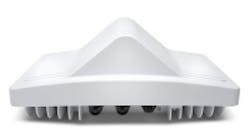Fastback upgrades intelligent backhaul radios to enable wireless multi-point services
Fastback Networks (San Jose, CA) recently announced an expansion of its Intelligent Backhaul Radio (IBR) product line to include support for both multi-point-to-point (M-PTP) and point-to-point (PTP) architectures, along with the company's new Extreme Interference Protection (XIP) features, as well as the launch of the ETSI-compliant device into the European market.
Fastback's IBR is an intelligent wireless transport device that enables high density LTE, LTE-A, and the future LTE and Wi-Fi radio access networks, with what the company claims is an industry-first transport mechanism for wireless delivery of fiber equivalent services in both line-of-sight (LOS) and completely non line-of-sight (NLOS) conditions. This new class of wireless device is comprised of an integrated carrier-grade switch and radio purpose-built for the requirements of new mobile networks.
See also: Report: Outdoor small cell backhaul market set to boom
According to Fastback, with its new M-PTP feature, the IBR delivers multi-point economic leverage while still preserving a fiber equivalent Service Level Agreement (SLA) on each link, which the company calls "an unprecedented capability" in a wireless backhaul solution. This feature extends the IBR’s PTP throughput and latency performance to multiple end points, providing greater coverage with fewer devices for LTE macrocell and small cell backhaul. As well, commercial and wholesale services can aggregate multiple ends points for economic leverage without compromising SLA requirements.
Also new to the platform, Fastback's Extreme Interference Protection (XIP) features enable support for usage of unlicensed wireless spectrum. The company notes that requirements for high performance LTE backhaul require far more spectrum capacity for backhaul, impacting capacity constraints for licensed bands and creating a challenge for mobile operators. In the past, unlicensed bands were rarely used for carrier-grade mobile backhaul because the devices could not effectively mitigate interference.
Now, the XIP feature, incorporating Fastback’s patented algorithms for interference mitigation, enables the IBR to sustain the high throughput and low latency service requirements of LTE backhaul while simultaneously mitigating even the severe levels of interference common in unlicensed spectrum. According to the company, the XIP feature mitigates the effects of uncoordinated and self-interference to enable new applications of unlicensed spectrum, including LTE macrocell and small cell backhaul.
Related: Point-to-point wireless backhaul platform targets utility providers
Fastback says the IBR's new interference mitigation capability enables sustained, carrier-grade performance in unlicensed spectrum to a SLA. This functionality establishes new levels of certainty and reliability for use of unlicensed spectrum, along with the advantages of tapping hundreds of MHz of available 5 GHz spectrum to relieve the capacity constraints of licensed bands.
“The IBR assures fiber equivalent services over wireless effectively creating fiber fill-in, and enabling mobile network operators to extend the reach of the service edge to provide anytime, anywhere access to services,” comments Kevin J. Duffy, CEO and co-founder of Fastback Networks. “We continue to expand the features and capabilities of the Fastback product line, providing the new requirements for speed, latency, and SLA assurance critical to LTE interfaces, such as S1 and X2, and essential to enabling emerging high density mobile networks.”
The Fastback solution is currently in trials with Tier 1 and 2 mobile network and services operators in the US and Europe, and deployed in first office application carrying live traffic in the cities of Los Angeles and New York. The ETSI-compliant IBR will be available beginning in the second quarter of 2014. The M-PTP capable IBR will be available in the third quarter of 2014. The company notes that its IBR has also been nominated for "Best Mobile Technology Breakthrough" for the the upcoming GSMA Global Mobile Awards.
More news: Report sees 5-year, $5 billion opportunity in outdoor small cell backhaul
About the Author
Matt Vincent
Senior Editor
Matt Vincent is a B2B technology journalist, editor and content producer with over 15 years of experience, specializing in the full range of media content production and management, as well as SEO and social media engagement best practices, for both Cabling Installation & Maintenance magazine and its website CablingInstall.com. He currently provides trade show, company, executive and field technology trend coverage for the ICT structured cabling, telecommunications networking, data center, IP physical security, and professional AV vertical market segments. Email: [email protected]

